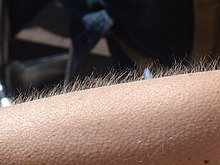Cold chill

A cold chill (also known as chills, the chills or simply thrills) is described by David Huron[clarification needed] as, "a pleasant tingling feeling, associated with the flexing of hair follicles resulting in goose bumps (technically called piloerection), accompanied by a cold sensation, and sometimes producing a shudder or shiver." Cold chills are a purely subjective response and, unlike piloerection, no objective physiological measure of cold chills exists. Unlike shivering, however, it is not caused by temperature, but rather is an emotionally triggered response[1] when one is deeply affected by things such as music,[2][3] speech, or recollection. It is similar to autonomous sensory meridian response; both sensations consist of a pleasant tingling feeling that affects the skin on the back of the neck and spine.[citation needed]
However, cold chills should not be confused with piloerection. Recent research has shown that self-reported chills do not correspond with observable piloerection,[4] suggesting that they are independent phenomena.
See also
[edit]References
[edit]- ^ Maruskin, Laura A.; Todd M. Thrash; Andrew J. Elliot (7 May 2012). "The Chills as a Psychological Construct: Content Universe, Factor Structure, Affective Composition, Elicitors, Trait Antecedents, and Consequences". Journal of Personality and Social Psychology. 103 (1): 135–157. doi:10.1037/a0028117. PMID 22564010.
- ^ David Huron. Biological Templates for Musical Experience: From Fear to Pleasure. Abstract Archived 2016-05-14 at the Wayback Machine
- ^ Panksepp, J. (1995). "The emotional sources of chills induced by music" (PDF). Music Perception. 13 (2): 171–207. doi:10.2307/40285693. JSTOR 40285693.
- ^ McPhetres, Jonathon; Han, Ailin; Gao, Halo H.; Kemp, Nicole; Khati, Bhakti; Pu, Cathy X.; Smith, Abbie; Shui, Xinyu (September 2024). "Individuals lack the ability to accurately detect emotional piloerection". Psychophysiology. 61 (9). doi:10.1111/psyp.14605. ISSN 0048-5772.
